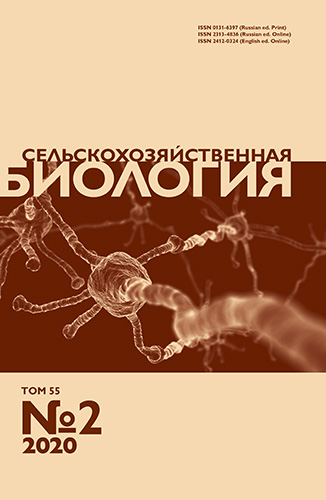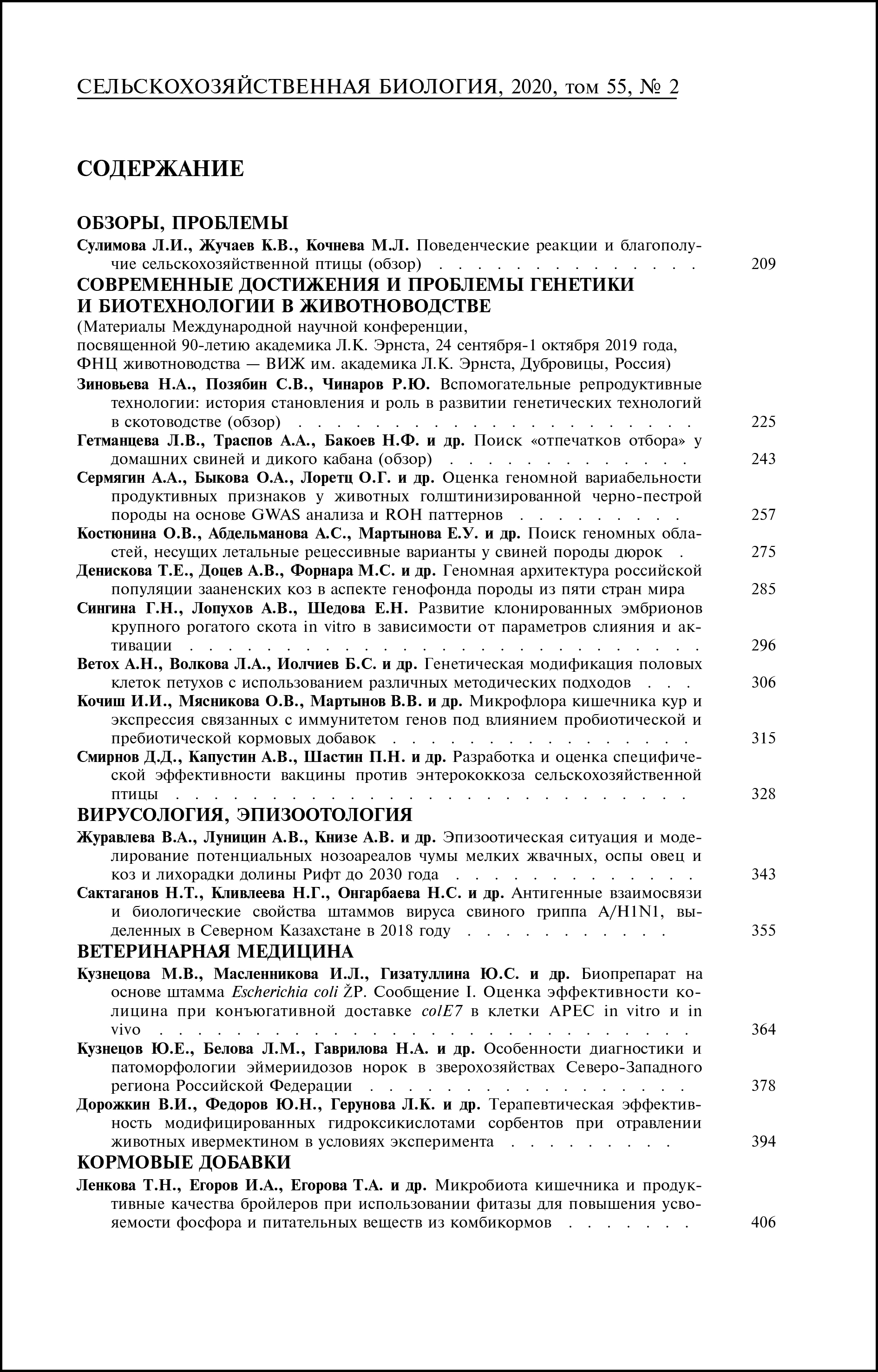doi: 10.15389/agrobiology.2020.2.209rus
УДК 636.52./58:57.026:591.1
ПОВЕДЕНЧЕСКИЕ РЕАКЦИИ И БЛАГОПОЛУЧИЕ СЕЛЬСКОХОЗЯЙСТВЕННОЙ ПТИЦЫ (обзор)
Л.И. СУЛИМОВА, К.В. ЖУЧАЕВ, М.Л. КОЧНЕВА
Обеспечение благополучия птицы и производство высококачественной продукции остаются актуальными проблемами как в мировом птицеводстве, так и в России в связи с необходимостью повышения конкурентоспособности отрасли (Welfare Quality® Assessment for poultry, 2009; I.J.H. Duncan, 1981; J.A. Mench, 1992). Особое внимание при улучшении благополучия животных придается соответствию между их биологическим особенностям и технологиями животноводства (D.A. Orlov c соавт., 2016). На благополучие сельскохозяйственной птицы влияют болезни, стрессы, питание, условия содержания (D.C. Jr Lay c соавт., 2011). Цель настоящего обзора — анализ нарушений поведения птицы в связи с ее неблагополучием, а также рассмотрение поведенческих предпочтений в качестве условий обеспечения благополучия. Птица в определенных пределах способна адаптироваться к различным условиям окружающей среды (M. Brantsæter c соавт., 2018). Неспособность к адаптации выражается в изменениях физиологического статуса, а также в нарушениях поведения, которые могут нанести вред и животным, и обслуживающему персоналу. Сильные проявления страха, такие как паника или резкие попытки побега, повышают энергозатраты и могут привести к повреждениям или даже смерти (S. Waiblinger c соавт., 2006). Страх как нежелательное эмоциональное состояние снижает общую активность животных. Регулярные отрицательные раздражители тормозят социальные взаимодействия (J.A. Mench, 2004; B. Forkman c соавт., 2007). Боязнь человека влияет на благополучие и продуктивность (T. Kutzer c соавт., 2015; M.A. Sutherland c соавт., 2012; F. Barone c соавт., 2018). Отношения человека и животного включают в себя визуальное, тактильное, обонятельное и групповое восприятие (S. Waiblinger c соавт., 2006). Птица чувствительна к визуальному контакту с человеком, но некоторые взаимодействия, такие как перемещение человеком руки на боковую часть клетки или приближение на короткое время, могут снизить ее пугливость (J.A. Mench, 2004). Оценка реакции животных позволяет сделать выводы о том, как они воспринимают всех людей или конкретного человека. Это зависит от вида животного и системы содержания, от характера его взаимодействий с человеком (позитивные, нейтральные или негативные), от качества ухода (S. Waiblin-ger c соавт., 2006). Понимание поведения — важный аспект концепции благополучия птицы (В.Н. Тихонов c соавт., 2008). С точки зрения обеспечения благополучия животных особо выделяют возможность проявлять природное поведение и наличие элементов в обстановке, приближающих ее к природной среде (Animal Welfare Issues Compendium; D. Fraser, 2008). Домашние куры сохранили значительную часть свойственных диким формам поведенческих потребностей (M.S. Dawkins, 1988). Главные из них — гнездование, пищевое и питьевое поведение, двигательная и комфортная активность, социальные взаимодействия (I.J.H. Duncan, 1998; T. Shimmura c соавт., 2018). Ограничение естественного поведения ведет к ухудшению благополучия птицы. Факторы окружающей среды, такие как высокая интенсивность света и скученность, также c высокой вероятностью провоцируют проявления нарушений поведения (M.C. Appleby c соавт., 2004). У животных, которые содержатся в неволе, могут проявляться так называемые стереотипии — повторяющиеся фиксированные циклы, выполняемые без видимого назначения, агрессивное поведение, расклевы яиц (G.J. Mason, 1991; M.C. Appleby c соавт., 2004; I.J.H. Duncan, 1998). Птица, содержащаяся в традиционных клеточных батареях (на 4-5 гол.), подвержена меньшему риску проблем с агрессивным поведением по сравнению с напольным содержанием из-за меньшего числа особей в группе (H. Lukanov c соавт., 2013). В то же время в бесклеточных системах размер группы может превышать 1000 гол., что расширяет возможности исследовательского поведения птицы, но повышает риск расклевов и каннибализма (D.C. Jr Lay c соавт., 2011). Именно поведенческие предпочтения животных служат основой для дизайна технологий, обеспечивающих их благополучие (M.S. Dawkins, 1988).
Ключевые слова: благополучие сельскохозяйственной птицы, поведение, нарушения поведения, поведенческие потребности, стресс.
POULTRY BEHAVIOR REACTIONS AND WELFARE (review)
L.I. Sulimova, K.V. Zhuchaev, M.L. Kochneva
In connection with the need to improve competitiveness with foreign poultry farming, the problem of ensuring the well-being of poultry and producing high-quality products is an urgent issue (Welfare Quality® Assessment for poultry, 2009; I.J.H. Duncan, 1981; J.A. Mench, 1992). Special attention on the way to improving the welfare of animals is given to the compliance of technology with the biological characteristics of animals (D.A. Orlov et al., 2016). The level of well-being of poultry is affected by many factors: illness, stress, nutrition, conditions of housing (D.C. Jr Lay et al., 2011). A bird within certain limits is able to adapt to various environmental conditions (M. Brantsæter et al., 2018). Inability to adapt is expressed in changes in physiological status, as well as behavioral disorders that can harm both animals and maintenance personnel. Stress sensitivity is manifested in the behavior of chickens, which serves as the best indicator of well-being. Strong manifestations of fear, such as panic or abrupt escape attempts, not only increase energy costs, but can also cause damage or even death when the birds start moving through obstacles and hurt each other (S. Waiblinger et al., 2006). Fear, like an unwanted emotional state, reduces the overall activity of animals. Regular negative stimuli inhibit social interactions between animals (J.A. Mench, 2004; B. Forkman et al., 2007). Human is one of the main sources of stress for animals, the fear of human affects their well-being and productivity (T. Kutzer et al., 2015; M.A. Sutherland et al., 2012; F. Barone et al., 2018). Relationships between humans and animals can include visual, tactile, olfactory, and group perception (S. Waiblinger et al., 2006). A hen is sensitive to visual contact with a person, but some neutral interaction, such as moving a person’s hands to the side of a cage or approaching a bird, even for short periods, can decrease stress (J.A. Mench, 2004). Measuring the response of animals to humans leads to conclusions about how they perceive all people or a particular person. It depends on the type of animal and the housing system, on the nature of its interactions with a person (positive, neutral or negative), on the quality of care for animals and poultry (S. Waiblinger et al., 2006). Understanding behavior is an important aspect of the concept of poultry welfare (В.Н. Тихонов et al., 2008). From the point of view of ensuring the welfare of animals, it is significant to have the possibility of living their natural life through the manifestation of natural behavior and the presence of elements in the environment that bring it closer to the natural environment (Animal Welfare Issues Compendium; D. Fraser, 2008). Poultry have retained a significant part of the behavioral needs of the wild forms (M.S. Dawkins, 1988). The main needs for the behavior of poultry are nesting, food and drinking behavior, the provision of physical and comfort activity and social interactions (I.J.H. Duncan, 1998; T. Shimmura et al., 2018). The restriction of natural behavior leads to a deterioration in the well-being of the bird. Environmental factors, such as high light intensity and crowding, also contribute to the high likelihood of behavioral disturbances (M.C. Appleby et al., 2004). Animals that are kept in captivity may exhibit behavioral disorders, including “stereotypes,” such as repetitive fixed cycles performed for no apparent purpose, aggressive behavior, pecking eggs (G.J. Mason, 1991; M.C. Appleby et al., 2004; I.J.H. Duncan, 1998). Hens contained in traditional cage batteries (for 4-5 heads) are less prone to problems with aggressive behavior due to the smaller number of birds in the group (H. Lukanov et al., 2013). At the same time, in floor systems, the size of the group can exceed 1000 heads, which expands the possibilities of the exploratory behavior of poultry, but increases the risk of peck and cannibalism (D.C. Jr Lay et al., 2011). The behavioral preferences of animals are the basis for designing technologies that ensure the animal welfare (M.S. Dawkins, 1988).
Keywords: poultry welfare, behavior, behavioral infractions, behavioral needs, stress.
ФГБОУ ВО Новосибирский государственный |
Поступила в редакцию |












